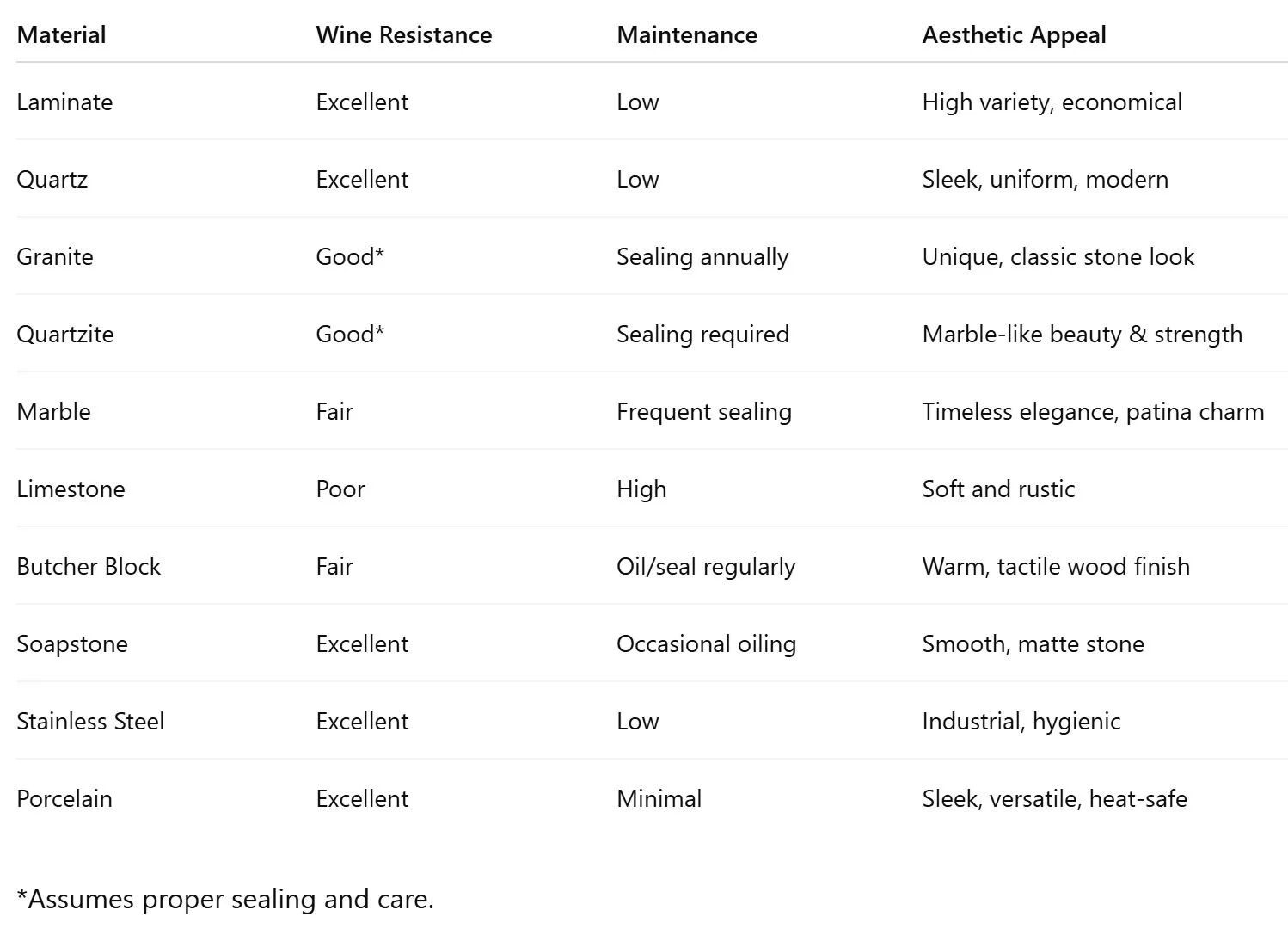Red wine vs Countertops
Understanding Countertop Materials: Durability, Aesthetics, and Wine Resistance
When it comes to choosing the right countertop material, there’s a rich history and wide variety of options available each with its own strengths, weaknesses, and aesthetic appeal.
Laminate: The Original Budget-Friendly Surface
One of the earliest and most widely used countertop materials was laminate. Made by heat-compressing layers of paper and resin, laminate is manufactured to imitate the look of other surfaces such as wood, stone, or concrete at a fraction of the cost. It’s extremely thin, impressively durable, and highly affordable, making it a popular choice for decades.
Despite its benefits, laminate has one notable drawback: if it chips, it is nearly impossible to repair seamlessly. However, its non-porous surface makes it highly resistant to stains from red wine or other acidic substances, which is a significant advantage in everyday kitchen use.
Granite: The Longstanding Natural Stone Favorite
Around the same era, granite entered the market as a premium, natural stone alternative. While still considered a more upscale choice, granite has become more accessible over time, with a range of pricing tiers depending on the rarity, origin, and finish of the stone.
Because granite is a quarried natural material, it’s available in various textures, including:
Polished (glossy and reflective),
Honed (smooth and matte), and
Leathered (textured with a soft sheen).
Granite is a very hard and relatively non-porous stone, meaning it resists red wine stains better than many other natural stones when properly sealed.
A Look at Other Stone Surfaces: Quartz, Quartzite, Limestone, Porcelain, and Marble
As design trends evolved, new materials gained popularity, each offering its own unique appeal:
Quartz: An engineered surface made from crushed quartz and resin. It’s highly durable, non-porous, low maintenance, and available in a wide range of colors and patterns, including those that mimic marble.
Quartzite: Often confused with quartz, quartzite is a natural stone. It's harder than granite but can be more porous depending on the specific type, requiring sealing to maintain stain resistance.
Limestone: Soft, porous, and best suited for low-traffic areas unless properly sealed and maintained.
Porcelain: An increasingly popular option, especially in modern kitchens. It’s ultra-durable, heat-resistant, and available in large-format slabs that resemble marble or concrete.
The Marble Myth: Is It Really That Risky?
Let’s address the common belief that marble should never be used in high-traffic or high-use areas like kitchens. While it’s true that marble is a softer, more porous material that can scratch, dull, and stain especially from substances like red wine or citrus it is absolutely possible to use marble in functional spaces with the right mindset and maintenance routine.
In fact, marble is a timeless, elegant choice that can elevate a kitchen design to a work of art. If you're aiming for a classic aesthetic and are prepared to embrace the natural patina that develops over time, marble is well worth considering assuming your budget allows.
Numerous manufacturers have attempted to recreate the look of marble in more durable and affordable materials, including quartz and porcelain. Some are impressively close, but in truth, nothing fully replicates the depth, veining, and natural variation of authentic marble.
Red Wine and Countertop Stains: What You Need to Know
It’s true, red wine CAN stain your countertops, especially if you’re dealing with more porous natural stones like marble, limestone, or unsealed granite. The best way to avoid long-term damage is to act quickly, clean spills immediately, and maintain proper sealing schedules for your surfaces.
For existing stains, especially on natural stone, the Natural Stone Institute is an excellent resource. One commonly recommended method is a paste made from baking soda and water, which can help lift stains without damaging the stone. However, always test in an inconspicuous area first or consult with a stone care specialist before proceeding.
Final Thoughts
Choosing the right countertop is about more than just looks. It’s a balance of lifestyle, maintenance expectations, and personal taste. Whether you're drawn to the affordability of laminate, the durability of quartz, or the timeless beauty of marble, understanding how each material behaves especially under the pressure of everyday use is key to making a decision you’ll love for years to come.
Would you like this version formatted as a downloadable guide or blog post? I can also include visuals or a countertop comparison chart if you’d like!
